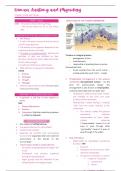Class notes
Class notes BSML-1104 Essentials of Human Anatomy & Physiology [Global Edition]
- Course
- Institution
- Book
Class notes BSML-1104 Essentials of Human Anatomy & Physiology [Global Edition] Human Anatomy and Physiology (Chapter 3 - Cells and Tissues)
[Show more]



